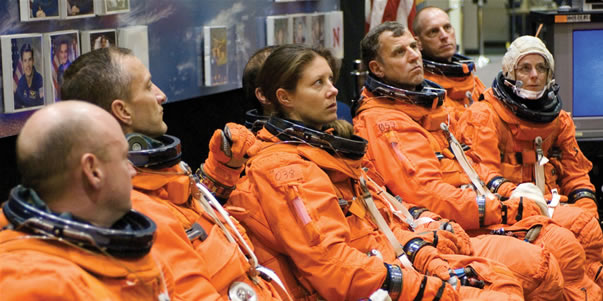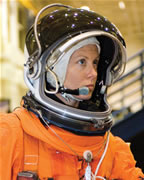Alumna Set for Maiden Space Voyage
Tracy Caldwell is scheduled to launch in August
May 1, 2007
By Russ Hudson
Training is intensifying for Cal State Fullerton alumna Tracy Caldwell and the other shuttle crew members who will launch sometime around August 9, depending on conditions, and point their craft at the International Space Station orbiting around the Earth.
Called Mission STS 118 by NASA, the purpose is to deliver crucial material to the station, including an external storage platform and logistics and supplies.
NASA announced that Caldwell will be on the STS 118 crew as a mission specialist in her first space flight.
Caldwell, who was chosen as an astronaut in June 1998 and began training in August that year, has performed several tasks, including spacecraft communicator in mission control. She received her bachelor’s degree in chemistry in 1993 and calls her education at Cal State Fullerton her launching pad. In particular, Caldwell cites John Olmstead and Scott Hewitt, her chemistry and biochemistry professors, as two major influences when she was a student.
Olmstead, Caldwell said, constantly encouraged her, telling her that she could be whatever she wanted to be, just as her father had done. When she graduated, she gave Olmstead a photo of the two of them affixed to a small model of a shuttle. When she returned to the campus six years later — as an astronaut — to give a speech, Olmstead still had it on his desk.
Caldwell recalled one incident in particular with Hewitt: The last day she spent in his lab, she stayed late. Hewitt directed her to a particular spot in the room that had equipment racks with many blinking lights. Then, he turned off the lights.
“What do you think?” he asked her. Caldwell wasn’t sure what he meant.
“Doesn’t it look like the cockpit of a space shuttle?” he asked.Years later, Caldwell recalled that moment: “That was just like him. Always rooting for me.”
Hewitt remembers, too, but from a different perspective.
“She had helped build this complex piece of equipment,” he said, referring to a laser-ionization time-of-flight mass spectrometer used for studying atmospherically relevant gas-phase chemistry. But, it needed an electronic safeguard so it could automatically shut down before overloading. Caldwell helped Hewitt design and build the device in 1993 before she left for graduate school at UC Davis, where she earned her doctorate in physical chemistry in 1997.
“It was her last night before she had to go,” Hewitt recalled. “She hadn’t even packed yet and it was maybe 10 o’clock at night. The device was installed but hadn’t actually functioned yet…. She was leaving, heading out for the next phase in her education and career, but she wanted to leave that project behind in perfect working condition. I was so impressed. One hour after she left the lab for the last time, it started working just as she’d designed it.”


